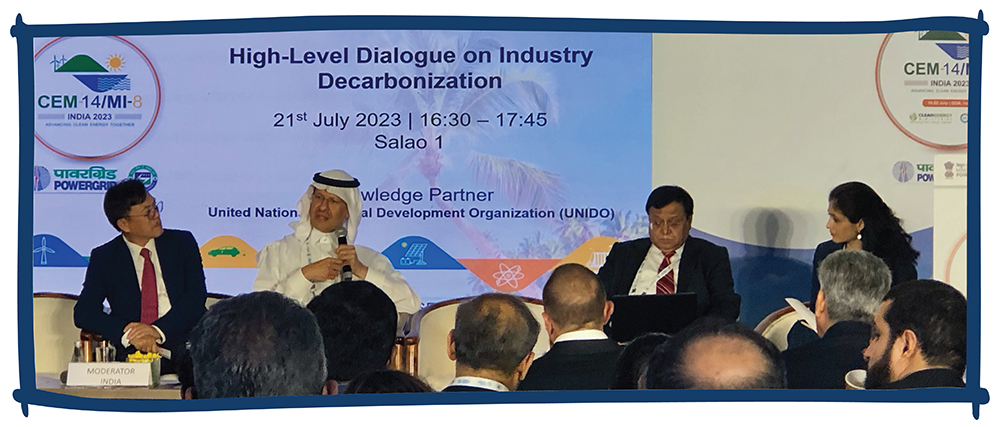Posted on August 3, 2023 by Nick Lombardo
Monsoon rains lashed a hazy coastline as energy ministers gathered in Goa, India, for the G20 Energy Transitions Ministers’ Meeting last month for the latest rounds of deliberations, quarrels, and announcements about the world’s clean energy and climate future. Modest progress was made among the parties to acknowledge and advance the role of critical technologies like hydrogen and carbon capture utilization and storage (CCUS); however, other conversations predictably broke down casting a gloomy picture for global clean energy deployment.
Russia and Saudi Arabia shoved back an agreement to triple renewable generation capacity by 2030, and China blocked cooperation on critical raw materials. Officials failed to agree on language criticizing Russia’s invasion of Ukraine that threw energy markets and supply chains into turmoil. Ultimately, the negotiations closed without an agreed joint communique ahead of the G-20 leaders meeting next month, instead settling for a non-binding “outcome document and chair summary.”
As intermittent blackouts shut out the lights in my hotel room in Goa, the plodding diplomatic progress of the G-20 ministers’ meeting stood in stark contrast to the immediate opportunities that exist to deliver energy security for the U.S., India, and other like-minded countries and address the global climate challenge.

Alongside the G-20 discussions, the Clean Energy Ministerial and Mission Innovation (CEM/MI) held its annual meeting. The CEM/MI is the only regular gathering of energy ministers focused exclusively on clean energy, with the hosting of the Ministerial meetings changing every year among the CEM/MI member governments. These conversations helped bring perspective to rapidly developing nations like India where energy security and reliability are equally imperative to deploying more clean energy. For the early part of this century, the country has exuded optimism and expectation for a brighter future, and it is remarkable to see the growing vibrancy of India’s clean energy policy ecosystem. However, on this trip I also heard true anxiety from friends in India – young urbanites in comfortable jobs, not subsistence farmers – about their future ability to live in the country with increasingly harsh weather conditions. Unfortunately, these worsening conditions and this growing anxiety are not unique to India.
That is why pragmatic American leadership with international partners – like India – is needed at multilateral energy and climate forums like CEM/MI to drive forward better understanding of next-generation technologies. It was very encouraging to see the prominent and deeply technical debates about CCUS technology happen in Goa. A decade ago, this was not the case with many in India and other countries outright dismissing the technology. Hydrogen was another hot topic of promising debate with thoughtful conversations about the pros and cons of green hydrogen versus – pick your color hydrogen – and the crux of ultimately figuring out how demand can meet supply.
Yet, there were notable gaps in the discussions at CEM/MI. The important role of advanced civil nuclear power in the global energy mix was mostly relegated to the far corners of conversation among us subversives who already believe in the technology’s game-changing potential for clean baseload generation. Likewise, there was surprisingly little talk about geothermal energy, hydroelectricity, and long-duration energy storage as essential pieces of the power puzzle. These areas and more should be elevated by U.S. delegates at the next CEM/MI gathering next year in Brazil.
Finally, there’s always the question of financing, with developing countries seeking solutions from developed countries. How can governments and the private sector better partner to design bankable clean energy projects at scale? The U.S. leverages agencies like the Development Finance Corporation (DFC), the Export-Import Bank (EXIM), and the U.S.-Trade and Development Agency (USTDA) to provide tools and lending options to bridge the financing gap in developing countries. But financing is not a silver bullet. In India, for example, the balance sheets of most of the public sector electricity distribution companies are not in good shape and inhibit the amount of clean energy that can be brought to the grid. The U.S. can only do so much to help partners and allies, and sometimes they need to make hard decisions to help themselves so that we can solve shared challenges together.
With every challenge comes opportunity, but you have to see it to seize it. Gatherings like CEM/MI are where problem solvers can exchange learnings and viewpoints to discover opportunities faster than they would on their own, and work toward achieving the international clean energy advancements we need.
